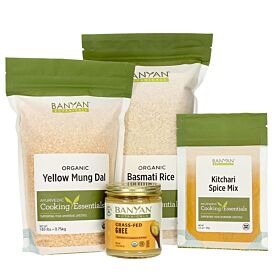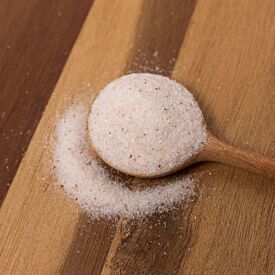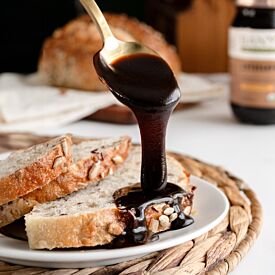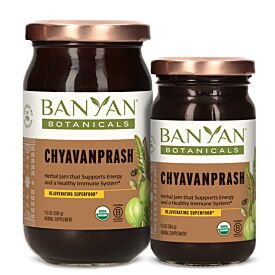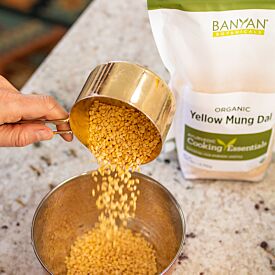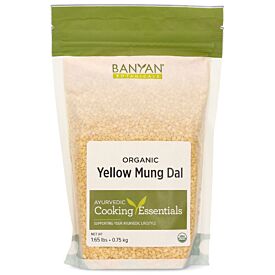5 Ways to Change Up Your Kitchari + Recipes
Originally published in 2021, we're resharing these tips and recipes so you can keep your kitchari feeling fresh and delicious!
In the world of Ayurveda, a nourishing meal of piping hot kitchari is considered a staple. This traditional dish of rice, lentils, and aromatic spices is easy to make, easy to digest, and easy to love!
Kitchari is also the foundation of an Ayurvedic cleanse, providing the perfect kind of sustenance to support your body through periods of detoxification and rejuvenation.
Like us, you may have experienced your own kitchari love affair—a head-over-heels infatuation that felt like it would never end. But if you’ve ever done an Ayurvedic cleanse, which features a monodiet of kitchari, you’ve probably also hit that mid-cleanse slump when the honeymoon period fades away and you just can’t face another bowl of kitchari.
When this happens, it’s good to have options up your sleeve so you can stay committed to your cleanse and come out successful in the end. And no, we don’t mean adding cheese or hot sauce to your meal, as tempting as it may be.
For kitchari to do its job while cleansing, it’s important that it remains simple, easy to digest, and balancing to the doshas—vata, pitta, and kapha. But that doesn’t mean your kitchari needs to be boring!
Here are a few ideas to get you started, and we encourage you to get creative and come up with your own kitchari variations as well.
Jump to the Recipes:
1. Switch Up Your Ratios
Most traditional kitchari recipes call for a combination of basmati rice and yellow mung dal. The basmati is known to be particularly easy to digest and gentle on the digestive tract, while the highly digestible dal adds an essential fiber and protein content to the meal.
This combination of rice and dal is an invaluable element of traditional Ayurvedic cleansing, as it provides enough protein content to sustain you throughout your cleanse without depleting your body of vital nutrients.
While it’s the combination of both of these ingredients that makes kitchari, well, kitchari, the exact amounts of rice and dal are certainly not set in stone. There is plenty of room to play around with using different ratios from batch to batch, and doing so can bring a completely fresh, new taste and texture to your cleanse meals, right when you need it most!
While our basic kitchari recipe calls for 1 cup of rice and ½ cup of dal, feel free to switch it up by adding more or less of these ingredients. Here are some ideas:
Use More Rice
Try using 1 ½ to 2 cups of rice and decreasing your cooking time just slightly. This will result in a kitchari that is more like a savory rice pudding, or something similar to congee. This variation will be extremely gentle on your digestive tract, giving your digestive fire (or agni) a chance to rest and reset.
Make sure that you use enough water to keep your kitchari on the soupier side, otherwise, the sticky quality of the rice may aggravate kapha dosha and prevent easeful, healthy elimination.
Use More Dal
Increasing the amount of dal to 1–2 cups will give your kitchari a taste and consistency that is closer to lentil soup and packed with fiber and protein. This variation is best for those with strong agni, as it requires more effort from the digestive system in order to break it down. It can be a great choice towards the end of your cleanse when your agni is burning bright and strong.
2. Try Quinoa Instead of Rice
Quinoa, often thought of as an “ancient grain,” is actually not a grain at all, but a seed! Often used in place of rice and other grains, it is easy to cook, easy to digest, and packed with nutrients. Considered a complete protein, quinoa offers all nine of the essential amino acids that the body needs.1 If you’ve never tried it, you may be pleasantly surprised!
This tiny vegetable seed, which is in the same family as beets and chard,2 cooks into a light, fluffy grain with a mild, slightly nutty flavor. With its impressive health benefits, it provides a delicious and satisfying way to nourish your body while cleansing—and bring a brand new spin to your kitchari.
The light, slightly warming, and nutrient dense qualities of quinoa make it a great choice for all three doshas, especially when cooked into this balanced, agni-boosting spring kitchari recipe.
Quinoa Kitchari Recipe with Spring Veggies
Ingredients:
- ½ cup quinoa (soaked)
- ¼ cup yellow mung dal (soaked)
- 1 teaspoon ginger powder
- ½ tablespoon fenugreek seeds
- 1 teaspoon turmeric powder
- 1–2 teaspoons mineral salt (to taste)
- 1 teaspoon coriander seeds
- ¼ cup chopped green onion
- 2 tablespoons chopped cilantro
- lime wedges
- black pepper (to taste)
- 3 cups water or vegetable stock (add more or less depending on your desired consistency)
- ½ tablespoon ghee or coconut oil, plus 1 teaspoon melted
- Spring vegetables: asparagus cut on a diagonal, halved bok choy, diced carrots (or any other spring veggies that call to you!)
Directions:
Soak the quinoa and yellow mung dal for at least four hours, or overnight, then rinse well.
Use a mortar and pestle to grind the fenugreek and the coriander seeds.
In a saucepan, heat the ghee or coconut oil on medium-low. Once melted, add the fenugreek and coriander, stir for 20–30 seconds, then add the powdered ginger and salt. Stir in the quinoa and mung dal until they are coated in the spices.
Add the stock or water and the turmeric powder. Bring to a simmer, then add the carrots and reduce the heat. Cover and cook for 15–20 minutes.
Meanwhile, in another saucepan with a steamer basket, bring some water to a boil. Without crowding the basket, line the bottom with the cut asparagus and halved bok choy. Cover and steam for 3–5 minutes, or until a knife can be released easily from the vegetable. Turn off the water, remove the basket, and add to a bowl. Add the melted ghee or coconut oil and toss with a little salt and pepper.
Check to ensure the quinoa and mung dal is cooked through. If not, you may need to add more liquid. Mix in the green onion and cilantro and add salt and pepper to taste.
To assemble, ladle your cooked quinoa into a bowl, then top with asparagus and bok choy. Sprinkle with salt, pepper, and lime juice. Bon appetit!
3. Cook the Dal and Rice Separately
When you’ve been cooking kitchari for days on end, it’s easy to fall into your own habits and tendencies and end up with a recipe that always comes out exactly the same way. If you’re ready to bring some new life to the taste and texture of your kitchari, as well as your entire cooking routine, try using the same ingredients in new and different ways.
Instead of cooking your rice, dal, and veggies all together in one pot, try cooking each element separately. This can provide a whole new meal experience without losing any of the essential kitchari ingredients. While we encourage you to get creative and have fun with this technique, here are a few ideas to get you started.
- Cook your rice in one pot, using either water or broth for a little extra flavor. You can even play with adding cumin or coriander seeds for variety. In another pot, cook your dal with Kitchari Spice Mix or another spice combination of your choice (keep reading for ideas!).
- Sauté your veggies in a separate pan to deepen their flavor and maintain a fresh, slightly crispy texture.
- Simply steam your veggies to maintain a maximum level of nutrients. With either of these methods, you can finish your vegetables in a sauce or with a simple toss of ghee, salt, and pepper.
4. Add Yummy Toppings
Adding new toppings to your bowl of kitchari is a fun and easy way to bring some pop, zest, fresh flavor, and additional health benefits to your meals. This is also a great way to personalize your kitchari when you are cleansing with others—start with a base of tridoshic kitchari, then add the toppings that are best for your unique constitution.
Depending on your dosha, the following toppings will add additional benefit and balancing qualities.
- Vata: Squeeze of lime, salt, fresh ginger, ghee, coriander chutney
- Pitta: Fresh cilantro, fresh dill, coconut flakes, ghee, coriander chutney
- Kapha: Squeeze of lime, fresh ginger, ghee, coriander chutney
Speaking of coriander chutney, here’s the recipe!
Fresh Coriander Chutney Recipe
Ingredients:
- 1 bunch (¼ lb.) fresh cilantro
- ¼ cup fresh lemon juice
- ¼ cup water
- ¼ cup grated coconut
- 2 tablespoons fresh ginger root, chopped
- 1 teaspoon barley malt or honey
- 1 teaspoon mineral salt
- ¼ teaspoon fresh ground black pepper
Directions:
Blend lemon juice, water, and fresh cilantro until cilantro is chopped. Add all remaining ingredients and blend until it is a paste-like consistency. This can be covered and stored in the refrigerator up to one week for an easy and delicious go-to addition to your meals.
5. Spice it Up in Fresh New Ways
We can all agree that without a rich blend of spices, kitchari just wouldn’t be the same. It’s the delicious, aromatic spices that make this dish so unique, recognizable, and easy to fall in love with. They are also what give kitchari the agni-boosting superpowers that make it the perfect food for times of cleansing, healing, and detoxification.
While our Kitchari Spice Mix provides an easy, authentic, time-tested option, it is certainly not the only option. Have you ever tried kitchari with Garam Masala, or fresh Mediterranean herbs like marjoram, parsley, and basil? What about a Thai-inspired kitchari with lemongrass, galangal, chili, and lime?
The options are endless! Play around with your own favorite spices, or try the following recipes when you feel stuck.
Sweet Cinnamon Breakfast Spice Blend
Featuring naturally sweet spices like cinnamon and cardamom, this blend can be used in the morning with your breakfast kitchari for a warm, comforting way to start your day.
Ingredients:
- 2 tablespoons cinnamon powder
- 1 ½ teaspoons ground clove
- 1 tablespoon ginger powder
- ½ teaspoon cardamom powder
Directions:
Blend all ingredients together, then store in a jar to use when desired (makes approximately ¼ cup of spice blend). Add one tablespoon to your morning kitchari with a pinch of salt and enjoy!
Berbere-Kitchari Spice Blend
Holy spice! Berbere is a cornerstone in Ethiopian cooking and is responsible for lending the heat and “kick” you find in traditional dishes like doro wat. This recipe will bring a unique flavor profile to your kitchari when you’re ready for something new and different.
Just keep in mind that this recipe is fiery, and you’ll want to adjust the spiciness to accommodate your dosha. For vata and pitta, go easy on the peppers and use sparingly. If you’re more kapha, you might benefit from a good punch of this blend!
Ingredients:
- 3 tablespoons sweet paprika
- 2 teaspoons cumin seeds
- 1 teaspoon coriander seeds
- ½ teaspoon fenugreek seeds
- 2 teaspoons ginger powder
- 2 teaspoons turmeric powder
- 1 teaspoon cayenne powder (or a few toasted dried chiles, ground)
- ½ teaspoon cardamom powder
- ¼ teaspoon allspice
- 1 teaspoon black pepper
- ½ teaspoon cinnamon powder
Directions:
Toast the cumin, coriander, and fenugreek seeds in a dry pan on high for about two minutes, being careful not to let them burn. Grind the toasted seeds in a mortar and pestle, then mix them with the powdered herbs.
Store the blend in a cool, dry place. If you are vata or pitta, consider leaving out the cayenne and powdered ginger and using fresh ginger in your kitchari instead.




